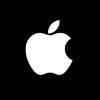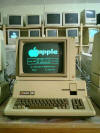Steve Jobs
Founder, Visionary, Innovator
The Apple Company
Apple started out with the Apple I, a computer designed by Steve Wozniak and turned into a business model by Steve Jobs. It featured a video display terminal circuit, setting it apart from other personal computers by being able to connect to composite monitors. This was a groundbreaking invention at the time. The duo was able to secure an order for 50 computers when Jobs demonstrated the computer at Palo Alto's Homebrew Computer Club by the Byte Shop, a local computer retailer. The Apple I was an inexpensive computer when compared to other computers at the time that were offered with several features, such as:
- BASIC interpreter
- MOS Technology 6502 processor
In recent years only a few Apple I computers remain and are on display in museums due to their historical significance.
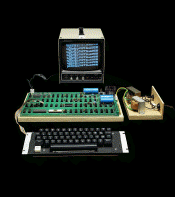
The follow-up to the Apple I was Apple II, a computer with a keyboard and a plastic case, unlike the Apple I. It was very successful and one of the most popular personal computers. It was popular for having bright and colourful graphics, and it was the first to display both uppercase and lowercase characters. Apple II replaced the Commodore PET in many American schools. In 1983, less than a decade from its founding, Apple became a Fortune 500 company.
Apple introduced the Apple III, a less successful model, but still was able to get 75,000 sales. The Apple III used the Apple SOS operating system, a play on the word “applesauce.” The Apple III was targeted at the business sector but was not that successful due to its design being more marketing-driven than engineered, resulting in a less-than-desirable product. They had put more effort into the marketing rather than the quality.
In 1984, Apple announced the Macintosh 128K, one of the world's first all-in-one personal computers. The model came with a built-in screen, a grap
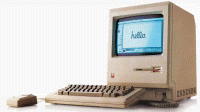 hical user interface (GUI), and a mouse. Priced at
$2,495 USD, which would be much more expensive in today’s society.
The Macintosh 128K was able to sell about 70,000 units in just a few
months. The Macintosh 128K was preloaded with MacWrite and MacPaint,
two applications that would showcase the capabilities of this new
system.
hical user interface (GUI), and a mouse. Priced at
$2,495 USD, which would be much more expensive in today’s society.
The Macintosh 128K was able to sell about 70,000 units in just a few
months. The Macintosh 128K was preloaded with MacWrite and MacPaint,
two applications that would showcase the capabilities of this new
system.
Despite Apple's early successes, the company struggled in the late 1980s and early 1990s with strong competition from IBM and limitations of the Macintosh itself, such as low performance and a limited choice of software. In 1985, Jobs left Apple to establish NeXT Computers. Even though NeXT developed advanced technology for scientific and financial applications, its high cost limited the success. In 1997, Apple bought NeXT for over $400 million USD, taking Jobs back as the interim chief executive of the company. He quickly changed Apple with his return, altering Apple to keep up with the advantages that Microsoft had at the time. This resulted in the Apple company creating the iMac, which was the starting point that turned Apple into the hugely successful company it is today.
One of his biggest contributions came through Apple introducing new products and branching out to software. iTun
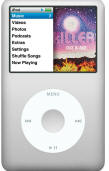 es was an innovative
computer program that let users play music digitally and is now used
as a media library for purchasing and downloading songs, movies, and
more. The iPod, a portable MP3 player, completely changed the way
people listened to music by switching from physical media to digital
media. It allowed users to store thousands of songs, photos, videos,
games, and even emails. The iPod reached its peak in 2008 and was
discontinued in 2013, having gained huge success due to its
affordability and integration with iTunes.
es was an innovative
computer program that let users play music digitally and is now used
as a media library for purchasing and downloading songs, movies, and
more. The iPod, a portable MP3 player, completely changed the way
people listened to music by switching from physical media to digital
media. It allowed users to store thousands of songs, photos, videos,
games, and even emails. The iPod reached its peak in 2008 and was
discontinued in 2013, having gained huge success due to its
affordability and integration with iTunes.
The iPhone was another huge innovation, being the first mobile phone to use multi-touch technology. It had an appealing design, an accelerometer, and a soft keyboard, other phones at the time had a physical keyboard. The iPhone ran iOS, which was a system Jobs envisioned to be a smaller operating system compared to Mac, yet bigger compared to the iPod. From there, it became one of the most popular smartphones in the world, with the latest release in 2024, the iPhone 16, and it has advanced technologies such as:
- Face ID
- High-resolution cameras
- 5G connectivity
- Siri
- Spatial audio recording
| iPhone 1 vs. iPhone 16 | ||
| Feature | iPhone 1 | iPhone 16 |
| Size | 3.5 inches | 6.1 to 6.7 inches |
| Camera | 2MP rear only | Triple-lens & 4K video |
| Battery Life | 7 hours video playback | 20+ hours video playback |
| Storage | 16 GB | 512 GB |
| Processor |
S5L8900 |
A18 chip |
